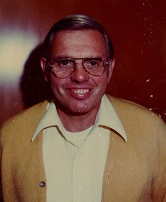
Verne H. Scott
Professor of Land, Air and Water Resources, Emeritus
Dr. V. H. Scott, Professor of Water Science and Civil Engineering in the Department of Land, Air and Water Resources (LAWR) passed away on December 16, 2020 in Sonora, California, preceded by his wife Dorothy of over 60 years who passed away in November 2013. An Oregon native, Verne attended Salem High School and later Willamette University just prior to and during WWII where he served as a seaman in the US Navy. Following the war, he completed BS and MS degrees in Civil Engineering at the University of Michigan, Ann Arbor. After completing his BSCE degree in 1945, he joined the growing ‘Department of Irrigation’ at UC Davis as a Lab Technician and later as an Instructor and a Junior Engineer. With completion of his Masters Degree in Civil Engineering, he became part of the regular Irrigation Department faculty in 1950 and later, taking a 1-year leave in 1959, he completed his PhD at Colorado State University (CSU) under Art Corey. During the 1960s, he served as chair of the newly named Department of ‘Water Science’ for nearly a decade, then later as Director of the Work-Learn Center in the 1970s. In the mid-1970s, he helped merge the Water Science department with the Soils and Plant Nutrition department and Atmospheric Sciences group of Agricultural Engineering to form the present day Department of Land, Air & Water Resources. Most appreciated during his tenure as Department Chair were the daily late morning coffee break discussions and weekly afternoon breaks/and discussions at the east end of Veihmeyer Hall. He worked some 40 years as a professor in the Departments of LAWR and Civil Engineering until his retirement in 1989.
Dr. Scott was passionate about teaching applied skills of value on irrigation and groundwater related hydraulics throughout his career. In the 1950s, his work focused on the practical aspects of irrigation turnouts, valves and siphons, flow measurements, canal liners and costs/optimization of groundwater pumping for irrigation. Later, with greater training in flow in porous media from CSU, he considered aspects of infiltration, flow to pumping wells and the newly evolving world of groundwater modeling and parametrization. Writing some 60 papers together with colleagues, they focused on practical problems of concern to irrigated agriculture. Verne worked with American Geophysical Union and Soil Science Society of America Fellows James Luthin and Art Corey. With Water Science department colleague Luthin, he contributed to the critically appreciated need for greater subsurface drainage in irrigated agriculture of California. Working in the same vadose-zone processes, while with petroleum engineer, Dr. Corey, Dr. Scott considered the water pressure distributions during steady flow in sands. Similarly, with Water Science department colleague Robert Burgy working for the California Department of Water Resources, they described the effects of fire on infiltrations rates and capacity in forest and rangeland soils at the Hopland Field Station and in the Sierra foothills. With one of his staff, Joseph Scalmanini, they considered efficient groundwater management, some four decades in advance of when California finally passed the Sustainable Groundwater Management Act. Both these research topics remain especially germane as the state faces ever-growing groundwater demands and increased fires across the state. Later, he helped Scalmanini form a locally successful engineering consulting firm in Woodland that continues to provide services related to groundwater management across California.
Dr. Scott’s teaching style epitomized that of a forever memorable teacher – one who is passionate about their subject and practical in their approach. He embodied the principles he taught and integrated applied research with its role in informing solutions to real world problems and policy. He was patient as he explained and demonstrated theories that were not always easy to instantly grasp, but his manner of teaching simplified learning complex theories. As an educator and mentor who cultivated joy in learning, he contributed invaluable guidance to his many students, including factors that shaped their career paths and ultimately their lives.
Not only passionate about teaching and irrigation related hydraulics, Verne carried this passion to swimming and athletics. Convinced that everyone should be active and can enjoy participation in athletics, he started the Davis Aquatic Masters in 1974, eventually creating one of the largest programs today in northern California. He is perhaps most recognized in Davis for his regular participation in the 6am workouts and regular ‘discussions’ with coaches and other swimmers during the workouts that contributed to the collegiality and enjoyment of all. He continued with US Master Swimming (USMS) throughout the 1970s and 1980s as a representative to Pacific Masters Swimming (PMS), a member of the PMS Board, chairman of PMS and then vice president of USMS in 1984. Following retirement, Verne and Dorothy moved to Boulder, Colorado in 2000 to be closer to their family where he continued swimming, teaching swimming and encouraging healthy, active living.
Mark Grismer
Vicki Kretsinger Grabert
Graham Fogg
